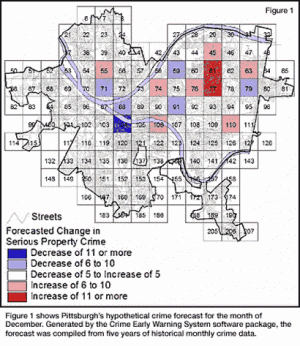Predictive law enforcementIT system allows police to predict crimes, better organize police shifts
Scientists have developed an IT system based in mathematical algorithms which allows to predict how many and what type of crimes are going to be committed in the next police shift. The developer say that it is about using scientific methods for police patrolling, and that it is the first case of predictive police methods are combined with a mathematical patrolling model.

Testing software in a hypothetical Pittsburgh // Source: cdu.edu
Scientists from the Spanish National Police Corps (CNP) and from the University of Granada (UGR) have developed an IT system based in mathematical algorithms which allows to predict how many and what type of crimes are going to be committed in the next police shift.
The University of Granada says that it is about using scientific methods for police patrolling, and that it is the first case of predictive police methods are combined with a mathematical patrolling model. This technology could allow better to organize police patrolling and districting, which would mean a reduction of the money spent and the number of victims of a crime.
The research has been carried out by Miguel Camacho Collados, police inspector at the Strategic Planning and Coordination Unit of the Spanish National Police Corps, and researcher at the Statistics and Operations Research Department of the UGR.
Part of this research has been carried out with the collaboration of UCLA and the LAPD, where Camacho Collados held a Fulbright fellowship last year.
The research is focused on dynamic systems applied to crime models, and it is aimed at influencing in the analysis and development of mathematical and statistical models for identifying temporal patterns for criminal acts.
U Granada notes that the system’s lead developer explains that the new system “is based in a mathematical, multi-criteria algorithm that, considering multiple performance attributes (such as workload, the patrolling area or the number of crimes committed in the last police shift), assigns the patrol a certain surveillance area, thus preventing the commission of crimes in the next shift, based on the crime risk prediction for that area.
“The main advance of our work -the UGR researcher continues- is that it strengthens crime prevention, not crime suppression. If we succeed in putting a Police officer in the right place at the right time we will save a lot in human resources and, which is even more important, we will have much less victims.”
Miguel Camacho explains that this new IT tool, which is able to stablish the patrolling area and distribute Police officers in just a minute, “can’t in any case be a substitute to police experience and intuition. It’s a help inspired in ‘big data’ technology which can be greatly useful in our job.”
